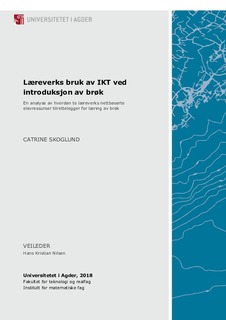| dc.contributor.author | Skoglund, Catrine | |
| dc.date.accessioned | 2018-09-21T08:35:26Z | |
| dc.date.available | 2018-09-21T08:35:26Z | |
| dc.date.issued | 2018 | |
| dc.identifier.uri | http://hdl.handle.net/11250/2563832 | |
| dc.description | Masteroppgave matematikkdidaktikk MA502 – Universitetet i Agder 2018 | nb_NO |
| dc.description.abstract | Fraction within mathematics is often considered a challenging and complex theme in elementary school. Digital learning tools can be used to promote learning. The purpose of this study is to investigate how fraction is introduced to pupils in third grade by two web-based learning resources. The study is based on two educational textbooks called Matemagisk and Multi, which both have developed web-based learning resources. To investigate how fractions is introduced, this study is based on the following research question:
How is fraction introduced in the web-based learning resources that are part of Matemagisk and Multi?
A prerequisite for using web-based learning resources is that they add something to teaching that traditional learning resources don´t achieve. The research question is therefore answered by examining technological and pedagogical learning opportunities that arise by introducing fraction through web-based learning resources.
The centrepiece in the theoretical framework is the study performed by Hadjerrouit (2017), where he assesses how the digital tool SimReal+ can support learning in mathematics. His model for analysis forms the basis for the development of this study's analysis tool. To answer the research question other relevant studies within digital learning resources are presented. In addition, literature within the concept of fraction and representations are also provided. The two educational textbooks are presented and described in a separate chapter. The study is a case study, where the two web-based learning resources each constitutes a case. It is therefore based on a qualitative research method, where the data collection is carried out through document analysis. The analysis tool is developed through interaction between an inductive and deductive approach. Two descriptive analyses have been conducted in relation to how fraction is introduced in the web-based learning resources.
The findings are derived from the two analyses that are based on predefined criteria and empirical observations. The results indicate several technological and pedagogical learning opportunities. Usability and functionality proved to influence how fraction were introduced. These two aspects also proved to be of importance regarding access to subject content and how pupils can navigate during the gaming activity. Furthermore, interactivity and multimodality were key aspects related to how fraction where introduced. They were important regarding feedback and how fraction was conveyed. | nb_NO |
| dc.language.iso | nob | nb_NO |
| dc.publisher | Universitetet i Agder ; University of Agder | nb_NO |
| dc.rights | Attribution-NonCommercial-NoDerivatives 4.0 Internasjonal | * |
| dc.rights.uri | http://creativecommons.org/licenses/by-nc-nd/4.0/deed.no | * |
| dc.subject | MA502 | nb_NO |
| dc.title | Læreverks bruk av IKT ved introduksjon av brøk : En analyse av hvordan to læreverks nettbaserte elevressurser tilrettelegger for læring av brøk | nb_NO |
| dc.type | Master thesis | nb_NO |
| dc.subject.nsi | VDP::Samfunnsvitenskap: 200::Pedagogiske fag: 280::Fagdidaktikk: 283 | nb_NO |
| dc.source.pagenumber | 71 s. | nb_NO |

